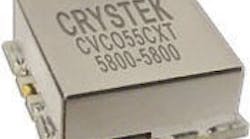Model CVCO55CXT-5800-5800 is a coaxial resonator oscillator (CRO) with internal frequency doubler. The combination results in output power of 0 dBm at an output frequency of 5800 MHz. The source has a tuning voltage range of 0.5 to 4.5 VDC and exhibits typical phase noise of -100 dBc/Hz offset 10 kHz from the carrier, The typical current consumption is 15 mA maximum at +8 VDC into a 50-Ω load. The CVCO55CXT-5800- 5800 CRO is packaged in the industry-standard 0.5-in x 0.5-in package. Pushing and pulling are both minimized to 1.5 MHz/V and 0.5 MHz, respectively. Second harmonic suppression is typically -30 dBc. The CVCO55CXT-5800- 5800 is ideal for use in applications such as digital radio equipment, fixed wireless access, satellite communications systems, and base stations.
Crystek Corp.
12730 Commonwealth Drive
Ft. Myers, FL 33913
(800) 237- 3061
(239) 561-3311
FAX: (239) 561-1025
e-mail: [email protected]
www.crystek.com

